|
Hawker Sea Fury FB.11
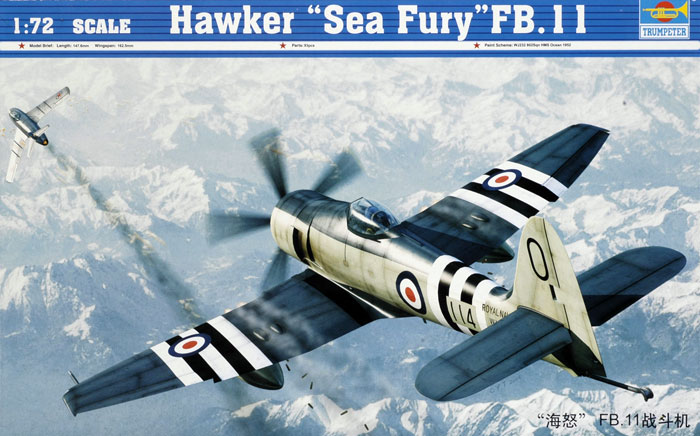
Trumpeter, 1/72 scale
S
u m m a r y
|
| Catalogue Number: |
Trumpeter Item No. 01631 Sea Fury
FB.11 |
| Scale: |
1/72 |
| Contents and Media: |
82 light grey plastic parts on three
sprues, 8 clear parts on one sprue, decals for two aircraft plus an A5
sized, 8 page fold-out instructions sheet with parts plan, 11 build
drawings and a separate full colour paint/decal page. |
| Price: |
USD$22.46 available online from Squadron.com |
| Review Type: |
FirstLook |
| Advantages: |
Highly detailed inside and out;
folding wings option; two piece injected canopy; optional drop tanks and
rockets. |
| Disadvantages: |
Propeller blades are an odd shape
and off centre; seam along outside of canopy |
| Recommendation: |
Highly Recommended. |
Reviewed
by
Brett Green

Trumpeter's 1/72 scale Sea Fury is available online from Squadron.com
Background
The Hawker Sea Fury is a navalised version of the aircraft
designed to replace the Typhoon/Tempest in production. It was designed to be
much smaller than the earlier aircraft hence the short wing span but the
fuselage grew. The RAF was not interested because they were getting into
jets so only the Royal Navy took up the option. It is now considered to be
one of the fastest single piston engined aircraft ever build and has been
extensively used in air racing.
The Model
When Trumpeter released their Wyvern in 1/72 scale we were
rapt. The level of detail was almost unbelievable. Then along came the
Gannet from the same company and although it was a gigantic improvement over
the old Frog/Revell kit, it lacked somewhat in detail.
So, when Trumpeter announced a Sea Fury we all wondered, would it be like
the Gannet or Wyvern? Well, I'm here to tell you, its not quite up to the
Wyvern but pretty close, and a big jump above the Gannet.
Seriously Guys and Gals, this is a superior kit.
The first thing I did on getting it home was compare it with some plans. Now
the only Sea Fury plans I have are those in the Warpaint book. The shape
looked good but the panel detail differed. But then again, the panel detail
in the plans also differed from those on the colour profiles in the same
book. So much for the plans. Well, it quacks like a duck.
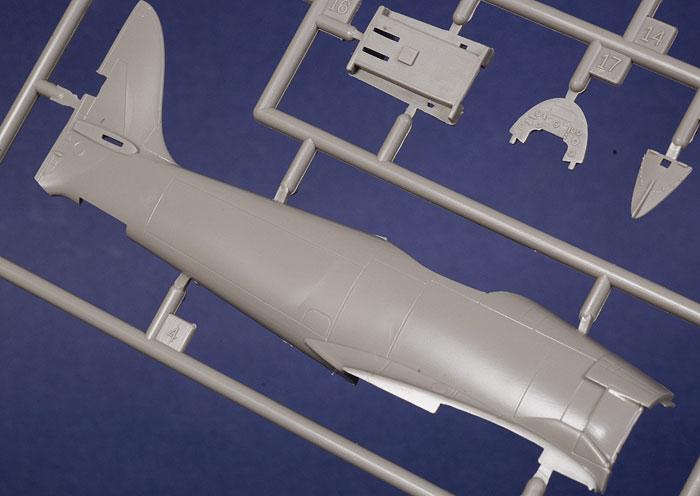
Click the thumbnails below to view
larger images:
[../../../photogallery/photo00000698/real.htm]
The first thing you will notice on opening the box is the
folding wing option. It is nicely detailed but the joints are slightly
simplified.
Detail in the cockpit is far superior to the Gannet. The consoles look very
short in the shallow cockpit, but comparison with the Special Hobby and High
Planes Sea Fury cockpits shows the same proportions so this may be correct.
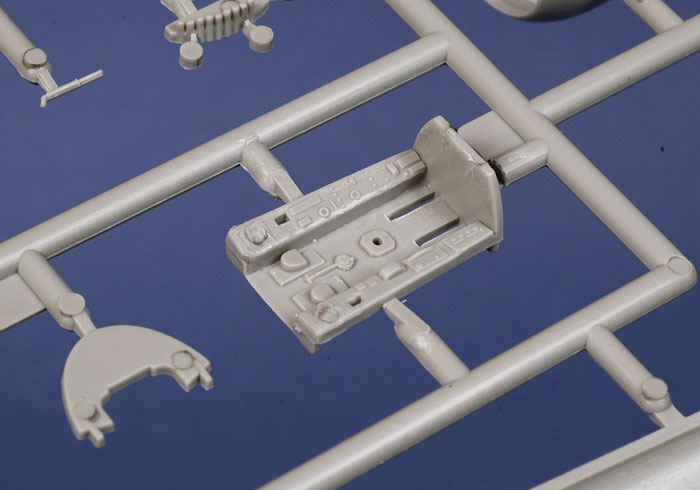
Next comes the five bladed prop. The shape of the blades does not conform
with photos and they do not line up with the centre. I should point out at
this juncture that the Special Hobby propeller is not real good but it is
better than this.
Perhaps this is something that Quickboost should look at
although it may not be all that noticeable once the propeller hub is hidden
under the big spinner.
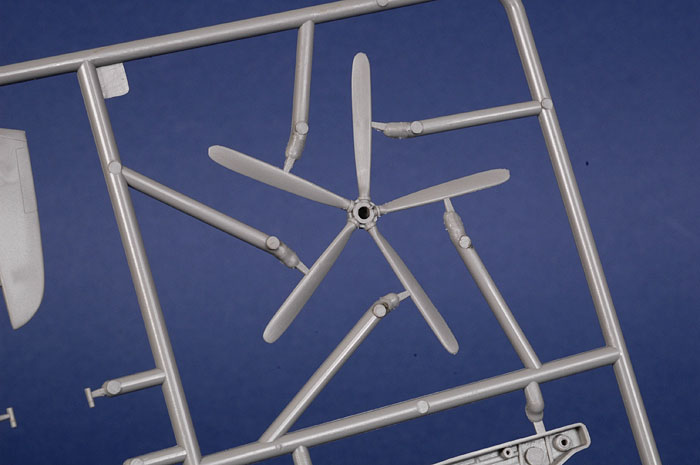
The two piece canopy is very clear and reasonably thin but it has a
noticeable seam down the middle of the sliding section. Like the Gannet, it
is only on the outside so it should not be too hard to clean up.
Okay, that's got the nit-picks out of the way. Let's have a look at the good
bits.
The “A” sprue carries all of the fuselage parts, separate engine cowl
halves, cockpit interior, prop and spinner, some under-carriage parts and
all the small bibs and bobs that are unidentifiable on the sprue. All are
beautifully moulded and detailed as we've come to expect from Trumpeter.
“B” carries the 9 wing parts, horizontal tail plane, drop tanks and outer
gear doors. The 9 wing parts consist of a lower centre section, two upper
inner wing sections plus two each of the upper and lower outer wing parts.
The two ailerons are separate although I don't think they are positionable.
Sprue “C”, which is attached to “B”, has the six rockets with separate tails
and the inner gear doors.
The last sprue, “D”, is the clear one and has eight parts attached. The
sliding canopy, as stated above, has that seam which I can now confirm is
only on the out side and therefore should not be a problem, is very clear
and thin. The windscreen is also very clear but is some what thick but us
Braille Scalers are getting used to that and it can either be ignored or
replaced with a vacformed item. There are two wingtip navigation lights, two
circular landing lights, a gun sight and rounding out the eight is a little
unidentified circular piece that goes in the side of the left fuselage
beneath the cockpit.
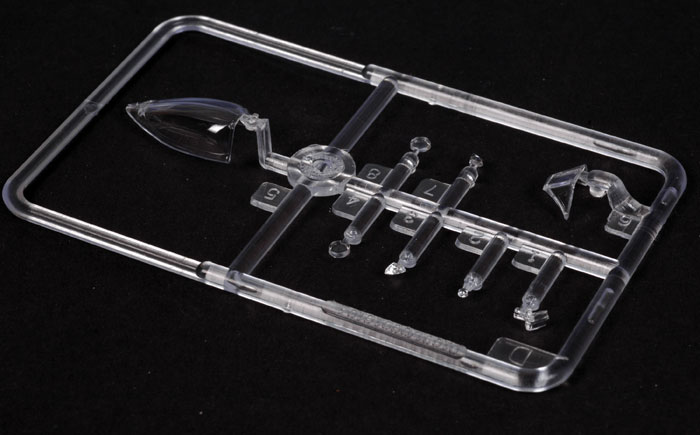
The decals are as we have come to expect from Trumpeter, well printed with
good colour density, perfect register and minimum carrier film and all the
major markings are present including Korean War stripes for Lt. Peter
Carmichael's WJ232 of 802 Sqn on HMS Ocean when he and some colleagues shot
down a North Korean Mig 15. The other aircraft present on the decal sheet is
WE683, an FB.11 from 1831 Sqn at RNAS Stretton in September 1953 with
temporary Red and Yellow wing and fuselage bands for Exercise Mariner. There
are no stencils of any kind and this is also true of both the Special Hobby
and High Planes kits.
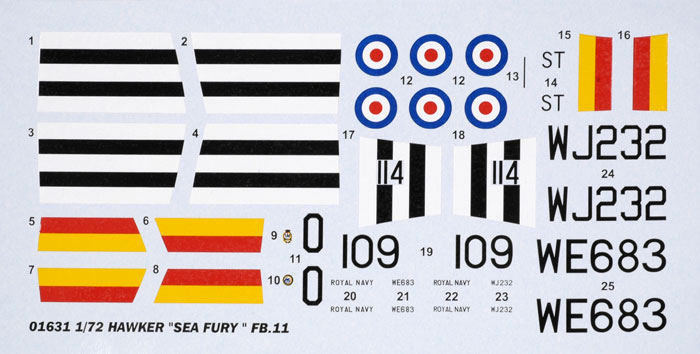
The instruction sheet is quite clear and easy to follow with a parts plan
and 11 build diagrams but no history (There is a small amount on the box
side). A separate colour guide is supplied in the form of a full colour A4
sheet with Gunze colours called out and decal positions indicated.
This is by far the best Sea Fury available at the moment
(not including the AKI kit for millionaires), and should be far easier to
build than either of the other two. This release is also a great improvement
over the Trumpeter Gannet in terms of detail.
No excuses fellows, get out there and build one, or two,
or...
Highly Recommended.
Sample purchased by HyperScale
Text and Images Copyright © 2007 by
Glen Porter
Page Created 15 August, 2007
Last updated 24 December, 2007
Back to HyperScale Main Page
Back to Reviews Page
|
Home
| What's New |
Features |
Gallery |
Reviews |
Reference |
Forum |